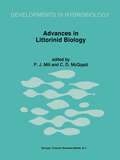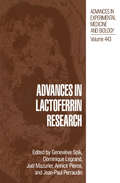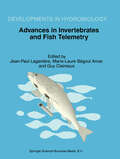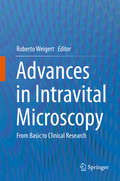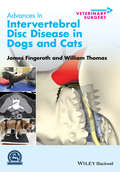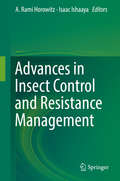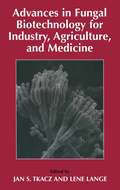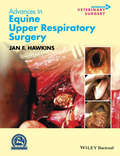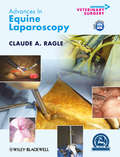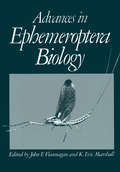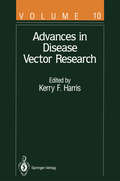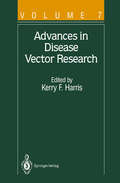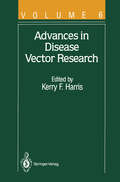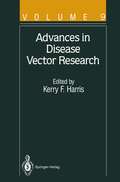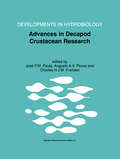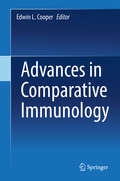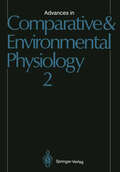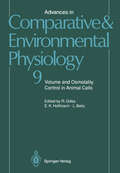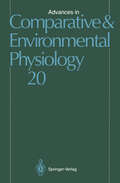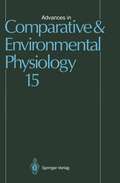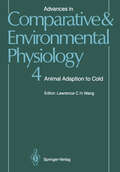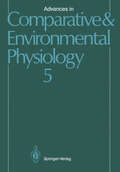- Table View
- List View
Advances in Littorinid Biology: Proceedings of the Fourth International Symposium on Littorinid Biology, held in Roscoff, France, 19–25 September 1993 (Developments in Hydrobiology #111)
by P. J. Mill C. D. McQuaidMembers of the gastropod family Littorinidae are common throughout the world. They form a very abundant component of many intertidal and shallow subtidal ecosystems and, by their grazing, often play a central role in shaping these communities. They also display a wide range of life history strategies and many are polymorphic, making them attractive model organisms for ecologists, evolutionary biologists and physiologists alike. Areas of particular interest include ecological interactions with other animals and with algae, the effects of pollutants and the use of littorinids as sentinel species for monitoring pollution, the effects of parasites on growth and ecology, taxonomy, and the study of genotypic/phenotypic responses to environmental factors. There is still much to be done, and the littorinids are proving to be an ideal group on which to work. Audience: Primarily targeted at the research level. Will also provide useful information for advanced first-degree students conducting research projects.
Advances in Lactoferrin Research (Advances in Experimental Medicine and Biology #443)
by Geneviéve Spik Dominique Legrand Joël Mazurier Jean-Paul ParraudinFollowing the two meetings on Lactoferrin Structure and Function that were held in Honolulu, Hawaii, in 1993 and 1995, the Third International Conference on Lactoferrin Structure and Function was held in Le Touquet, France, and has successfully reinforced and diversified the previously created bridges between biochemists, clinicians, and companies. In fact, scientists, physicians, and people of industry from different domains have brought a wealth of recent information concerning biochemistry and technical advances in the identification of lactoferrin-derived compounds as well as cell biology, molecular biol ogy, pathology, and medical applications of lactoferrin and lactoferrin-derived com pounds. We were so delighted with the rapid growth of knowledge concerning many biologi cal and immunological functions of lactoferrins and the relationships between their struc ture and function, we wanted to share our pleasure with the readers interested in this field. The present book. which represents a review of some of the most exciting contributions, is intended to reflect the status of our knowledge and transmit our hopes for the future devel opment of in vivo applications of natural and recombinant lactoferrins. We would like to express our gratitude to the sponsors who contributed to the or ganization of the meeting in such a pleasant place and allowed the participation of several young researchers. We would also like to thank all the participants who have answered with enthusiasm our invitation and to every one of the Laboratoire de Chimie Biologique for the constant and efficient help.
Advances in Invertebrates and Fish Telemetry: Proceedings of the Second Conference on Fish Telemetry in Europe, held in La Rochelle, France, 5–9 April 1997 (Developments in Hydrobiology #130)
by Jean Paul Lagardere Marie-Laure Begout Anras Guy ClaireauxThis volume provides a selection of the most significant papers presented at the Second Conference on Fish Telemetry in Europe in La Rochelle, France, in April 1997. The conference was attended by 100 scientists from 18 countries. The contributions are grouped under the following headings: Methodology and New Developments, Tagging Procedures, Behavioural and Physiological Ecology, Fish Migration, Stock Management and Conservation. Particular emphasis was put on tag miniaturisation, multiple functions and sampling strategies. Papers concerned the effects of tags on fish for consolidating behavioural or original physiological investigations noticeably more open to the marine environment. Methods were essentially applied to study the relationships between fish and their natural environment. Besides providing up-to-date information on the state of fish telemetry, the book illustrates the increase in spatial and temporal scales and the number of tracked fish which gives a statistical basis for field study in behavioural ecology.
Advances in Intravital Microscopy: From Basic to Clinical Research
by Roberto WeigertThis is the first book entirely dedicated to Intravital Microscopy. It provides the reader with a broad overview of the main applications of Intravital Microscopy in various areas of the biomedical field. The book contains accurate descriptions of the state of the art methodologies used to image various organs at different level of resolution, ranging from whole tissue down to sub-cellular structures. Moreover, it is an extremely valuable guide to scientists that want to adopt this powerful technique and do not have experience with animal models and microscopy.
Advances in Intervertebral Disc Disease in Dogs and Cats (AVS Advances in Veterinary Surgery)
by James M. Fingeroth William B. ThomasAdvances in Intervertebral Disc Disease in Dogs and Cats defines our present knowledge of this common clinical problem, compiling information related to the canine and feline intervertebral disc into a single resource. As a comprehensive, focused work, the book is an authoritative reference for understanding and treating disc disease, providing a sound scientific and clinical basis for decision making. Offering an objective synthesis of the current literature, the book supplies guidance on the approach to a potential disc rupture, surgical and medical strategies, and management of the patient. Offering a complete understanding of intervertebral disc disease, the book describes and discusses the controversies and issues surrounding this topic, acknowledging the gaps in our knowledge. Advances in Intervertebral Disc Disease in Dogs and Cats presents up-to-date, reliable information on this common condition for veterinary surgeons, neurologists, and general practitioners.
Advances in Intervertebral Disc Disease in Dogs and Cats (AVS Advances in Veterinary Surgery)
by James Fingeroth William ThomasAdvances in Intervertebral Disc Disease in Dogs and Cats defines our present knowledge of this common clinical problem, compiling information related to the canine and feline intervertebral disc into a single resource. As a comprehensive, focused work, the book is an authoritative reference for understanding and treating disc disease, providing a sound scientific and clinical basis for decision making. Offering an objective synthesis of the current literature, the book supplies guidance on the approach to a potential disc rupture, surgical and medical strategies, and management of the patient. Offering a complete understanding of intervertebral disc disease, the book describes and discusses the controversies and issues surrounding this topic, acknowledging the gaps in our knowledge. Advances in Intervertebral Disc Disease in Dogs and Cats presents up-to-date, reliable information on this common condition for veterinary surgeons, neurologists, and general practitioners.
Advances in Insect Control and Resistance Management
by A. Rami Horowitz Isaac IshaayaThis book covers advanced concepts and creative ideas with regard to insect biorational control and insecticide resistance management. Some chapters present and summarize general strategies or tactics for managing insect pests such as the principles of IPM in various crop systems and biorational control of insect pests, advances in organic farming, alternative strategies for controlling orchard and field-crop pests. Other chapters cover alternative methods for controlling pests such as disruption of insect reproductive systems and utilization of semiochemicals and diatomaceous earth formulations, and developing bioacoustic methods for mating disruption. Another part is devoted to insecticide resistance: mechanisms and novel approaches for managing insect resistance in agriculture and in public health.
Advances in Fungal Biotechnology for Industry, Agriculture, and Medicine
by Jan S. Tkacz Lene LangeIn the past half century, filamentous fungi have grown in commercial importance not only in the food industry but also as sources of pharmaceutical agents for the treatment of infectious and metabolic diseases and of specialty proteins and enzymes used to process foods, fortify detergents, and perform biotransformations. The commercial impact of molds is also measured on a negative scale since some of these organisms are significant as pathogens of crop plants, agents of food spoilage, and sources of toxic and carcinogenic compounds. Recent advances in the molecular genetics of filamentous fungi are finding increased application in the pharmaceutical, agricultural, and enzyme industries, and this trend promises to continue as the genomics of fungi is explored and new techniques to speed genetic manipulation become available. This volume focuses on the filamentous fungi and highlights the advances of the past decade, both in methodology and in the understanding of genomic organization and regulation of gene and pathway expression.
Advances in Equine Upper Respiratory Surgery (AVS Advances in Veterinary Surgery)
by Jan HawkinsAdvances in Equine Upper Respiratory Surgery is a comprehensive, up-to-date reference on surgical techniques in the upper respiratory tract in the horse, presenting theory and background as well as detailed procedures information. Part of the Advances in Veterinary Surgery series copublished with the ACVS Foundation, the book covers the most common upper respiratory diseases, with in-depth information on laryngeal hemiplegia and dorsal displacement of the soft palate. Providing a complete resource, the book reflects the current state of the art, offering a significant update on disorders of the nasal septum, nasal passage, paranasal sinuses, hard and soft palate, epiglottis, arytenoids, guttural pouch, and trachea in the horse. The book includes 200 images illustrating key points of each surgical procedure. Potential complications and expectation management are discussed alongside the technique information. Advances in Equine Upper Respiratory Surgery is a useful reference for those in clinical practice and surgical residents.
Advances in Equine Upper Respiratory Surgery (AVS Advances in Veterinary Surgery)
by Jan HawkinsAdvances in Equine Upper Respiratory Surgery is a comprehensive, up-to-date reference on surgical techniques in the upper respiratory tract in the horse, presenting theory and background as well as detailed procedures information. Part of the Advances in Veterinary Surgery series copublished with the ACVS Foundation, the book covers the most common upper respiratory diseases, with in-depth information on laryngeal hemiplegia and dorsal displacement of the soft palate. Providing a complete resource, the book reflects the current state of the art, offering a significant update on disorders of the nasal septum, nasal passage, paranasal sinuses, hard and soft palate, epiglottis, arytenoids, guttural pouch, and trachea in the horse. The book includes 200 images illustrating key points of each surgical procedure. Potential complications and expectation management are discussed alongside the technique information. Advances in Equine Upper Respiratory Surgery is a useful reference for those in clinical practice and surgical residents.
Advances in Equine Laparoscopy (AVS Advances in Veterinary Surgery #3)
by Claude RaglePart of the Advances in Veterinary Surgery series copublished with the ACVS Foundation and Wiley-Blackwell, Advances in Equine Laparoscopy presents a state-of-the-art reference on laparoscopic skills and procedures in the horse. Chapters are written by the leading experts in the field, and each section includes a practical review of the published literature. Encompassing instrumentation, basic principles, and specific techniques, Advances in Equine Laparoscopy offers an up-to-date, reliable resource for comprehensive information about equine laparoscopy. This current, well-referenced text begins with a section on the fundamentals of laparoscopy, then moves into sections on the clinical application of laparoscopic techniques in the standing or recumbent horse. A companion website offers eight video clips demonstrating selected procedures at www.wiley.com/go/ragle. Advances in Equine Laparoscopy is an invaluable guide for equine surgical specialists and equine clinicians interested in laparoscopic techniques.
Advances in Equine Laparoscopy (AVS Advances in Veterinary Surgery)
by Claude A. RaglePart of the Advances in Veterinary Surgery series copublished with the ACVS Foundation and Wiley-Blackwell, Advances in Equine Laparoscopy presents a state-of-the-art reference on laparoscopic skills and procedures in the horse. Chapters are written by the leading experts in the field, and each section includes a practical review of the published literature. Encompassing instrumentation, basic principles, and specific techniques, Advances in Equine Laparoscopy offers an up-to-date, reliable resource for comprehensive information about equine laparoscopy. This current, well-referenced text begins with a section on the fundamentals of laparoscopy, then moves into sections on the clinical application of laparoscopic techniques in the standing or recumbent horse. A companion website offers eight video clips demonstrating selected procedures at www.wiley.com/go/ragle. Advances in Equine Laparoscopy is an invaluable guide for equine surgical specialists and equine clinicians interested in laparoscopic techniques.
Advances in Disease Vector Research (Advances in Disease Vector Research #10)
by El Desouky Ammar Y. Antignus T. R. Burkot E. P. Camargo Y. Chinzei S. Cohen D. Gonsalves P. M. Graves H. H. Hagedorn R. Hull E. I. Korenberg Yu. V. Kovalevskii G.W. Otim-Nape M. K. Shaw A. J. Shelley W. J. Tabachnick DeMar Taylor J. M. Thresh F. G. Wallace S. D. Yeh A. S. YoungVolume 10 of Advances in Disease Vector Research consists of seven chapters on vectors that affect human or animal health and six chapters on plant pathogens and their vectors. In Chapter 1, Yasuo Chinzei and DeMar Taylor discuss hormonal regulation of vitellogenesis in ticks. Many blood sucking insects and ticks transmit pathogens by engorgement, which induces vitellogenesis and oviposition in adult animals. To investigate the pathogen transmission mechanism in vector animals, information on the host physiological and endocrinological conditions after engorgement is useful and important because pathogen development or proliferation occurs in the vector hosts at the same time as the host reproduction. Chinzei and Taylor have shown that in ticks, juvenile hormone (JH) is not involved in the endocrinological processes inducing vitellogenin biosynthesis. Synganglion (tick brain) factor(s) (vitellogenesis inducing factor, VIF) is more important to initiate vitellogenesis after engorgement, and ecdysteroids are also related to induction of vitellogenin synthesis. In their chapter, based mainly on their own experimental data, the authors discuss the characterization of main yolk protein, vitellogenin (Vg) , biosynthesis and processing in the fat body, and hormonal regulation of Vg synthesis in tick systems, including ixodid and argasid ticks.
Advances in Disease Vector Research (Advances in Disease Vector Research #7)
by Christopher J. Andrews Richard H. Bagnall Nick Carter Claude Chastel John R. DeLoach Karen S. Gibb Richard Harrington Ian Humphery-Smith Ian Maudlin John W. Randles Ramesh C. Sinha George SpatesAdvances in Disease Vector Research (Advances in Disease Vector Research #6)
by S. Barbagallo M. R. Brown W. Burgdorfer F. H. Collins V. Finnerty D. A. Golino S. F. Hayes H. Hibino A. O. Lea G. P. Martelli J. Nedelman G. N. Oldfield S. M. Paskewitz R. T. Plumb A. H. Purcell B. Raccah C. N. Roistacher C. E. Taylor R. D. WardI think the reader will agree that we have attained a good balance in Volume 6 between human-or animal-host and plant-host-related topics from outstanding research scientists. In Chapter 1, Frank Collins, Susan Paskewitz, and Victoria Finnerty explore the potential of recombinant DNA technology to distinguish indi vidual species and to establish phylogenetic relationships among member species in the Anopheles gambiae species complex, which includes the principal malaria vectors. Currently, relatively little is known about these morphologically identical species that are sympatric over most of their range but are not always equally involved in malaria transmission. With respect to individual species identification, the researchers have thus far described two DNA fragments, derived from the ribosomal DNA interge nic spacer region, that reliably distinguish five species in the complex by means of an RFLP visualized on a Southern blot. They have also described other species-specific fragments derived from a ribosomal DNA intron that could form the basis for a rapid dot blot assay. With respect to the phylogenetic relationships among member species in the complex, Collins, Paskewitz, and Finnerty focus on a comparison at the level of restriction site mapping and Southern analysis of the rDNA intergenic spacer regions. As expected, the two spacer regions near the coding region junctions are well conserved among the species, whereas the central regions tend to be highly variable among member species in the complex.
Advances in Disease Vector Research: Volume 9 (Advances in Disease Vector Research #9)
by J. J. Cho D. M. Custer T. L. German R. Gothe U. B. Gunashinghe P. J. Ham W. B. Hunter M. Klein W. J. Kloft R.F.L. Mau R. G. Milne G. I. Mink A. S. Raikhel J. Richardson E. S. Sylvester D. E. Ullman D. M. WestcotVolume 9 in this series consists of four chapters on vectors that affect human or animal health and six chapters on plant pathogens and their vectors. In Chapter 1, Alex S. Raikhel discusses vitellogenesis in mosquitoes: the cornerstone of the reproductive cycle involving massive production of yolk precursors by the fat body and their accumulation in developing oocytes. In anautogeneous mosquitoes, vitellogenesis is dependent on the availability of a blood meal and, as a consequence, is linked to transmission of pathogens. Therefore, elucidation of mechanisms governing the mosquito vitellogenesis is critical for the successful development of novel strategies in vector and disease management. Previous reviews on mosquito vitellogenesis have dealt predominantly with hormonal control. The goal of this review, however, is to summarize significant progress which has been achieved in understanding mosquito vitellogenesis at the cellular, biochemical and molecular levels. It is with these disciplines that we expect to fully understand the mechanisms governing this key process in mosquito reproduction.
Advances in Decapod Crustacean Research: Proceedings of the 7th Colloquium Crustacea Decapoda Mediterranea, held at the Faculty of Sciences of the University of Lisbon, Portugal, 6–9 September 1999 (Developments in Hydrobiology #154)
by José P.M. Paula, Augusto A.V. Flores & Charles H.J.M. FransenDecapod crustaceans are a particularly important animal group in a variety of aquatic environments, such as freshwater, estuaries, and oceans. Research on this group has increased during recent decades, and relates to their economic and ecological importance. The papers included reflect current trends in decapod crustacean research, and present results on a diversity of specific research fields, grouped into the major themes: a) Systematics, Phylogeny, and Biogeography, b) Growth, Morphology, and Development, c) Ecology and Behaviour, d) Reproduction, and e) Fisheries and Culture. The Colloquia Crustacea Decapoda Mediterranea are devoted to decapod crustacean research, and organised on a 3-year basis by institutions of the Mediterranean geographical area. The scope of these meetings has progressively widened throughout the sequence of events, and presently welcomes contributions from crustacean research world-wide.
Advances in Comparative Immunology
by Edwin L. CooperImmunologists, perhaps understandably, most often concentrate on the human immune system, an anthropocentric focus that has resulted in a dearth of information about the immune function of all other species within the animal kingdom. However, knowledge of animal immune function could help not only to better understand human immunology, but perhaps more importantly, it could help to treat and avoid the blights that affect animals, which consequently affect humans. Take for example the mass death of honeybees in recent years – their demise, resulting in much less pollination, poses a serious threat to numerous crops, and thus the food supply. There is a similar disappearance of frogs internationally, signaling ecological problems, among them fungal infections. This book aims to fill this void by describing and discussing what is known about non-human immunology. It covers various major animal phyla, its chapters organized in a progression from the simplest unicellular organisms to the most complex vertebrates, mammals. Chapters are written by experts, covering the latest findings and new research being conducted about each phylum. Edwin L. Cooper is a Distinguished Professor in the Laboratory of Comparative Immunology, Department of Neurobiology at UCLA’s David Geffen School of Medicine.
Advances in Comparative and Environmental Physiology (Advances in Comparative and Environmental Physiology #2)
by G. A. Ahearn J. M. Bouquegneau C. Joiris W. H. Karasov J. Machin M. J. O'Donnell L.C.H. Wang S. H. WrightAdvances in Comparative and Environmental Physiology provides comprehensive, integrated reviews giving sound, critical, and provocative summaries of our present knowledge in environmental and comparative physiology, from the molecular to the organismic level. The field has now gained the international status it deserves and the organization of a series devoted to it is very timely in view of its actual rapid development. Biologists, physiologists, and biochemists, independently of their basic scientific orientation, will find this new series of major interest.
Advances in Comparative and Environmental Physiology: Volume and Osmolality Control in Animal Cells (Advances in Comparative and Environmental Physiology #9)
by T. Arawaka M. B. Burg H. F. Cserr J. J. Grantham S. Grinstein E. K. Hoffmann H. K. Kimelberg H. A. Kolb R. O. Law J. W. Lohr A.D.C. Macknight M. J. Mason C. S Patlak D. Rotin S. N. TimasheffAdvances in Compararative and Environmental Physiology helps biologists, physiologists, and biochemists keep track of the extensive literature in the field. Providing comprehensive, integrated reviews and sound, critical, and provocative summaries, this series is a must for all active researchers in environmental and comparative physiology. Cellular volume and osmolality in animals is a well studied topic and this specific volume in the series provides the reader with a thorough grounding in this area of physiology. Consisting of two parts, the text discusses osmolality and volume control in terms of both inorganic and organic ions which as a result gives an excellent overview to those working and interested in this field.
Advances in Comparative and Environmental Physiology: Volume 20 (Advances in Comparative and Environmental Physiology #20)
by J. L. Arpigny J. Coyette S. Davail G. Feller E. Fonze E. C. Foulkes J. M. Frere R. Fujii S. Genicot C. Gerday B. Joris J. Lamotte-Brasseur J. N. Maina E. Narinx M. Nguyen-Disteche N. Oshima A. Vairengo Z. ZekhniniADVANCES IN COMPARATIVE AND ENVIRONMENTAL PHYSIOLOGY helps biologists, physiologists, and biochemists keep track of the extensive literature in thefield. Providing comprehensive, integrated reviews and sound, critical, and provocative summaries, this series is a must for all active researchers in environmental and comparative physiology. The present volume contains six reviews on: - Motile Activities of Fish Chromatophores. - Epithelial Transport of Heavy Metals. - Heavy Metal Cytotoxicity in Marine Organisms. - Comparative Pulmonary Morphology and Morphometry. - Molecular Adaptations in Resistance to Penicillins. - Molecular Adaptations of Enzymes From Thermophilic and Psychrophilic Organisms.
Advances in Comparative and Environmental Physiology: Volume 15 (Advances in Comparative and Environmental Physiology #15)
by G. F. Ball J. Balthazart M. Hidaka I. Novak M. WheatlyAdvances in Comparative and Environmental Physiology helps biologists, physiologists, and biochemists keep track of the extensive literature in the field. Providing comprehensive, integrated reviews and sound, critical, and provocative summaries, this series is a must for all active researchers in environmental and comparative physiology.
Advances in Comparative and Environmental Physiology: Animal Adaptation to Cold (Advances in Comparative and Environmental Physiology #4)
by J. A. Boulant R. J. Brooks M. C. Curras T. J. Dawson W. R. Dawson J. B. Dean D. D. Feist D. A. Galbraith J. R. Hazel B. A. Horwitz D. M. Lavigne T. F. Lee R. A. MacArthur R. L. Marsh R. D. Myers D. A. Rosen J. M. Storey K. B. Storey L.C.H. Wang R. G. WhiteWhen survival is challenged by the cold, animals react by employing both behavioral and physiological solutions. Depending on the magni tude of the cold stress and the nature of the adjustment, simple avoidance or sophisticated capacity or resistance compensations may be used. Thus, migration, shelter seeking, metabolic and insulative compen sation, torpor, and freezing avoidance and tolerance are successful tac tics used by diverse groups of animals. To understand and appreciate the benefits of these tactics, it is necessary to examine not only the well being of the whole animal but also their basic underlying mechanisms. In ad dition, it is also of fundamental importance to grasp how seasonal cold affects the survivorship and reproductive success of populations when confronted by a general reduction in primary productivity and an elevated energy cost for maintenance (e. g. in endotherms). In this regard, a synthetic overview which integrates aspects of cell biology, biochem istry, physiology, neurobiology, behavior, and population biology should be a fruitful approach in providing a holistic understanding on how animals adapt to cold. The present volume is an attempt to achieve such an overview; its objective is to provide a depth and breadth of coverage that is essential to a full appreciation of animal adaptation to cold. It is the hope of the contributing authors that this book will serve as an effective reference text for all senior undergraduate and graduate students as well as research scientists with an interest in cold physiology.
Advances in Comparative and Environmental Physiology (Advances in Comparative and Environmental Physiology #5)
by M. Brouwer W.E.S. Carr W. Ross Ellington D. W. Engel R. A. Gleeson B. Korsgaard T. S. Moerland T. Mustafa D. J. Prior B. D. Sidell K. C. Srivastava H.G. Trapido-Rosenthal R. E. Weber R. W. WisemanAdvances in Comparative and Environmental Physiology helps biologists, physiologists, and biochemists keep track of the extensive literature in the field. Providing comprehensive, integrated reviews and sound, critical, and provocative summaries, this series is a must for all active researchers in environmental and comparative physiology.
